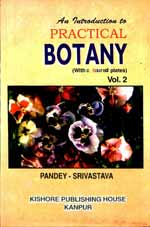|
वनस्पति विज्ञान >> एन इन्ट्रोडक्शन टु प्रैक्टिकल बॉटनी - 2 एन इन्ट्रोडक्शन टु प्रैक्टिकल बॉटनी - 2डॉ. एस एन पाण्डेयके सी श्रीवास्तव
|
|
||||||
एन इन्ट्रोडक्शन टु प्रैक्टिकल बॉटनी - 2
According to State level Unified syllabus of Botyany for B.Sc.I, Paper II for Universities of Uttar Pradesh. Language English
CONTENTS
1. Taxonomy of Angiosperms 1-5
General description-Definition, Herbaria, Classification
2. Inflorescence: Kinds 6-12
3. Description of Flowers 13-25
Terminology, How to describe flowers Key to
4. Identification of Families 26-29
5. Systematic Enumeration of Plants 31-270
Ranunculaceae 31-39
Ranunculus (31), Clematis (34), Nigella (36), Delphinium (38)
Annonaceae 40-41
Polyalthia (40)
Nymphaeaceae 42-43
Nymphaea (42)
Papaveraceae 44-49
Papaver (44), Funaria (46), Argemone (48)
Cruciferae 50-57
Brassica (50), Coronopus (Senebiera) (52), Iberis (54), Cherianthus (56)
Capparidaceae 58-63
Capparis (58), Cleome (60), Gynandropsis (62)
Violaceae 64-65
Viola (64)
Caryophylleae (Caryophyllaceae) 66-75
Dianthus (66), Saponaria (68), Gypsophila (70), Stellaria (72) Spergula (74)
Malvaceae 76-85
Hibiscus (76). Sida (78), Malva (80), Althaea (82), Aburilon (84)
Rutaceae 86-89
Cirrus (86), Murraya (88)
Meliaceae 90-91
Azadirachta (90)
Leguminosae (Sub-family Papilionatae) 92-107
Pisum (92), Melilotus (96), Indigofera (98), Lathyrus (100) Cajanus (102). Clitoria (104), Sesbania (106)
Leguminosae (Sub-family Cacsalpinioideae) 108-121
Cassia fistula (108), Cassia tora (110), Cassia occidentalis (112), Caesalpinia (114). Tamarindus (116). Bauhinia (118), Delonix (120)
Leguminosae (Sub-family Mimosoideae) 122-125
Acacia (122), Mimosa (124)
Rosaceae 126-129
Potentilla (126), Prunus (128)
Myrtaceae 130-133
Eucalyptus (130), Callistemon (132).
Lythraceae 134-135
Lawsonia (134)
Cucurbitaceae 136-143
Coccinia (136), Cucurbita (140), Luffa (142)
Umbelliferae 144-147
Foeniculum (144), Coriandrum (146)
Rubiaceae 148-155
Ixora (148), Hamelia (150), Mussaenda (152), Oldenlandia (154) ,
Compositae 156-171
Helianthus (156), Launaea (160), Ageratum (162), Vernonia (164) Sonchus (166), Eclipta (168), Tageims (170)
Primulaceae 172-173
Anagalis (172)
Apocynaceae 174-181
Catharanthus (Vinca) 174, Nerium (176). Thevetia (178) Tabernaemontana (Ervatamia) 180
Asclepiadaccac 182-185
Calotropis (182), Asclepias (184)
Convolvulaceae 186-191
Cuscuta (186), Ipomoea (188), Convolvulus (190)
Solanaceae 192-199
Solanuin (192), Petunia (194), Datura (196), Nicotiana (198)
Scrophulariaceae 200-207
Scoparia (200), Lindenbergia (202). Russelia (204), Antirrhinum (206) .
Acanthaceae 208-219
Ruellia (Dipterocanthus) (208), Barleria (210), Asystasia (212) Peristrophe (214), Adhatoda (216), Justicia (218).
Verbenaceae 220-225
Duranta (220). Lantana (222), Clerodendrum (224)
Labiate 226-233
Ocimum (226), Salvia (228), Coleus (230), Leucas (232)
Amarantaceae 234-241
Amarantus (234), Achyranthes (236), Digera (238), Aerua (240)
Polygonaceae 242-247
Antigonon (242), Polygonum (244), Rumex (246)
Euphorbiaceae 248-261
Euphorbia (248). Euphorbia hirta syn. Euphorbia pilulifera (250) Phyllanthus (252), Croton (254), Ricinus (256), Jatropha (258) Acalypha (260),
Liliaceae 262-270
Asparagus (262), Asphodelus (264), Allium (266)
Gramineae (Poaceae)
Triticum (268)
6. General Spot Comments 271-304
Morphology : 1. Fusiform roots, 2. Leaf roots, 3. Climbing roots, 4. Epiphytic (Aerial) roots, 5. Runner stems. 6. Off-set stem, 7. Hook climber (stem), 8. Climber (stem), 9. Phylloclade (stem), 10. Cladode (stem), 11. Rhizome (stem). 12. Tuber (stem). 13. Corm (stem), 14. Bulb (stem).
Leaves : 15. Tendril Climber (leaf). 16. Leaf hook (leaf), 17. Phyllode (petiole),
Inflorescences : 18. Compound Umbel Inflorescence. 19. Spadix Inflorescence. 20. Capitulum Inflorescence, 21. Helicoid Cymnose Inflorescence, 22. Verticillaster Inflorescence, 23. Cyathium Inflorescence, 24. Hypanthodium Inflorescence, 25. Scapigerous Cyme inflorescence, Fruits: 26. Cypsella fruit., 27. Legume or pod fruit, 28. Follicle fruit, 29. Siliqua fruit, 30.Capsule fruit, 31. Loculucidal capsule fruit, 32. Regma (Schizocarpic) fruit, 33. Cremocarp fruit, 34. Carcerulus fruit. 35.Drupe (Succulent) fruit, 36. Pome fruit, Insectivorous, Parasitic and Other plants: 37. Sundew (Drosera). 38. Bladderwort. 39. Pitcher plaut. 40. Stem parasite. 41. Vivipary. Embryology: 42. T.S.of Anther, 43. Ovules, Gynoecium 44/45. L.S. of Carpel (Ranunculus and Polygonu). Placentation: 46. Marginal placentation, 47. Free central placentation. 48. Axile placentation, 49. Parietal placentation, Endosperms: 50. Free nuclear. 51. Cellular, and 52. Helobial endosperm, Embryos: 53. Dicotyledonous and 54. Monocotyledonous embryo.
7. Anatomical Studies 305-324
Section - 1 (Tissue System) : Special types of tissues. Tissue system in plants,
Section -2 (Stem): Helianthus, Cucurbita, Tinospora, Zea mar's, Asparagus.
Section-3 (Roots): Tinospora, Ficus, Funda.
8. Abnormal Anatomical Structures 325-348
General description, Nyctanthes, Boerhaavia, Bougainvillea, Amaranthus, Chenopodium, Achirunthes, Bignonia, Salvadora, Argreia, Lepiadenia, Strychnos, Dracaena.
9. Physiology Experiments 349-403
Experiments on general physiology of the cell; Imbibition; Osmosis; Plasmolysis; Ascent of sap. Root pressure, Transpiration, Photosynthesis, Respiration, Enzymes, Growth, Movement and Chromatography.
10. Emasculation and Hybridisation 405-413
Emasculation : 1. Emasculation in Pea (Pisum sativum), 2.Emasculation in Sweet Pea (Lathyrus odoratus), 3. Emasculation in Datura (Dalura stramonium) 4. Emasculation in Wheat (Triticum vulgare).
11. Mendel's Laws of Heredity 414-419
12. Cell Division 420-430
Mitosis and Meiosis
13. Biochemistry 431-432
|
|||||














